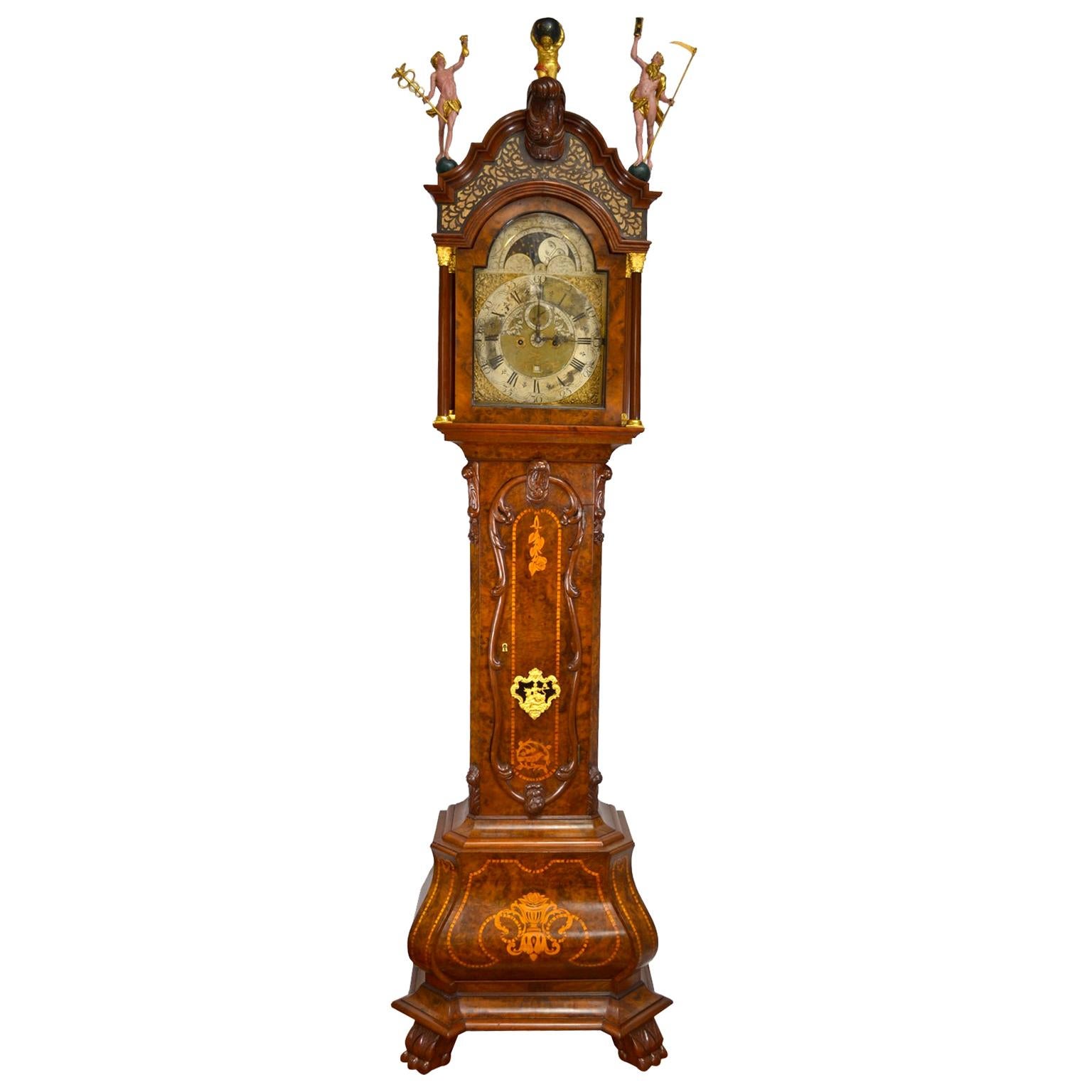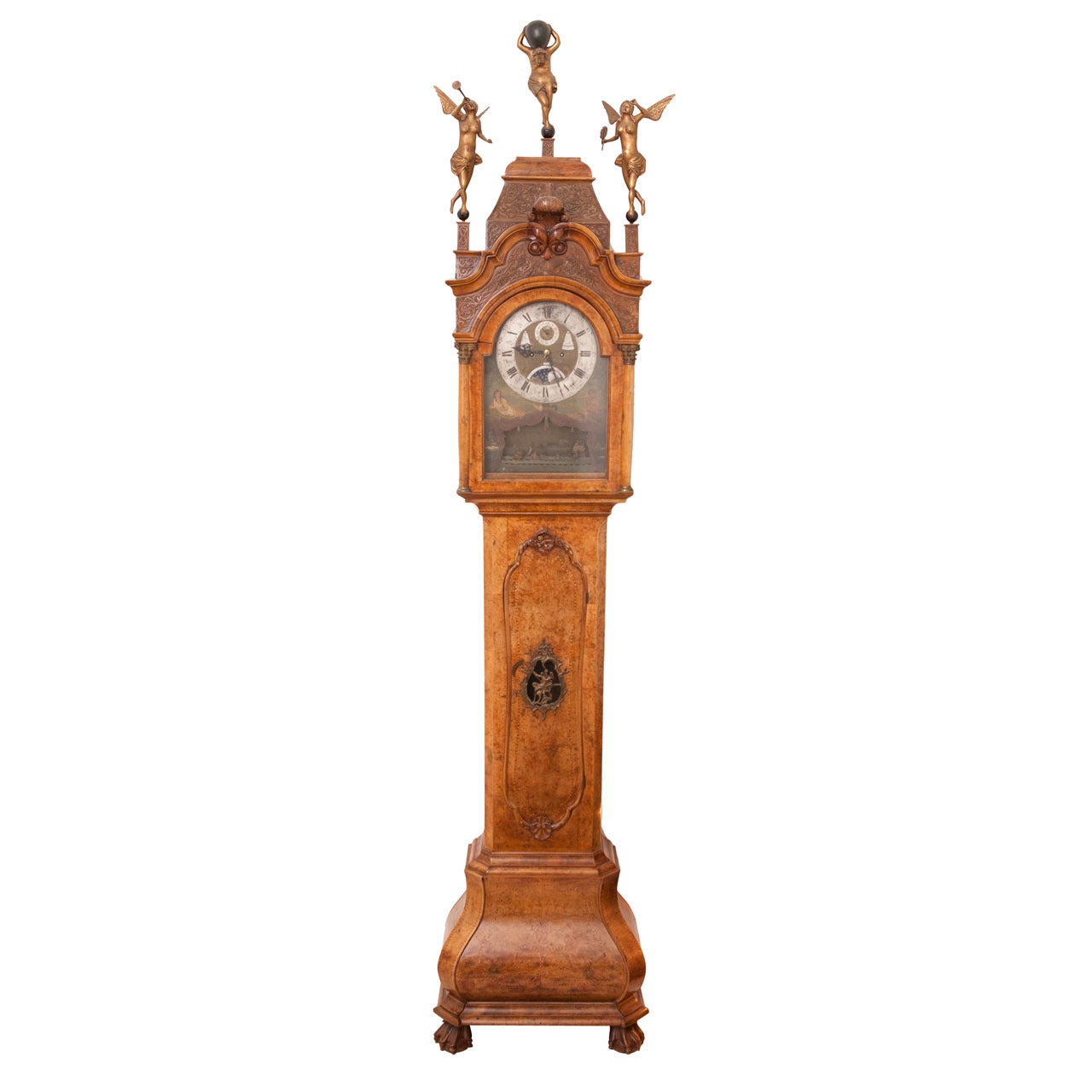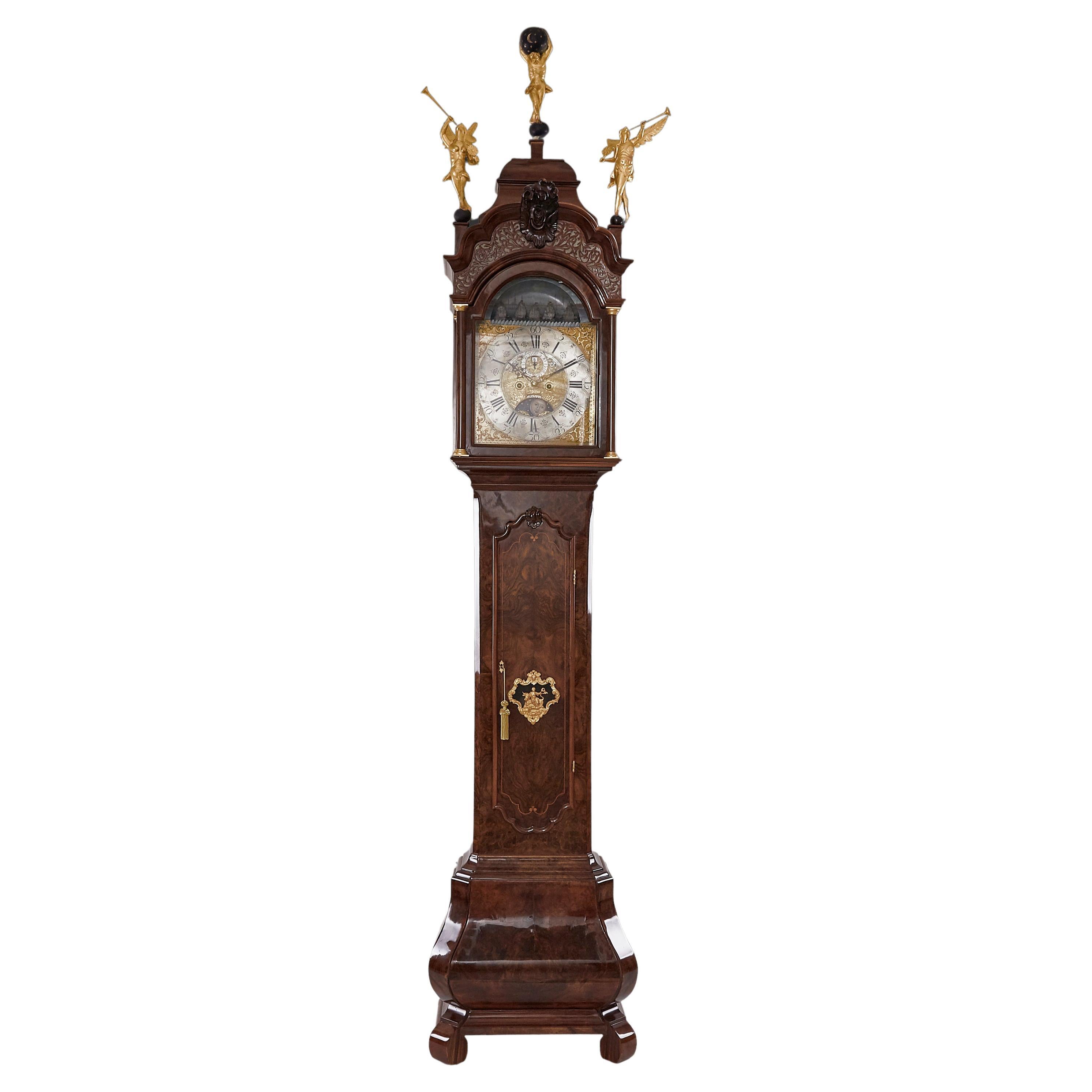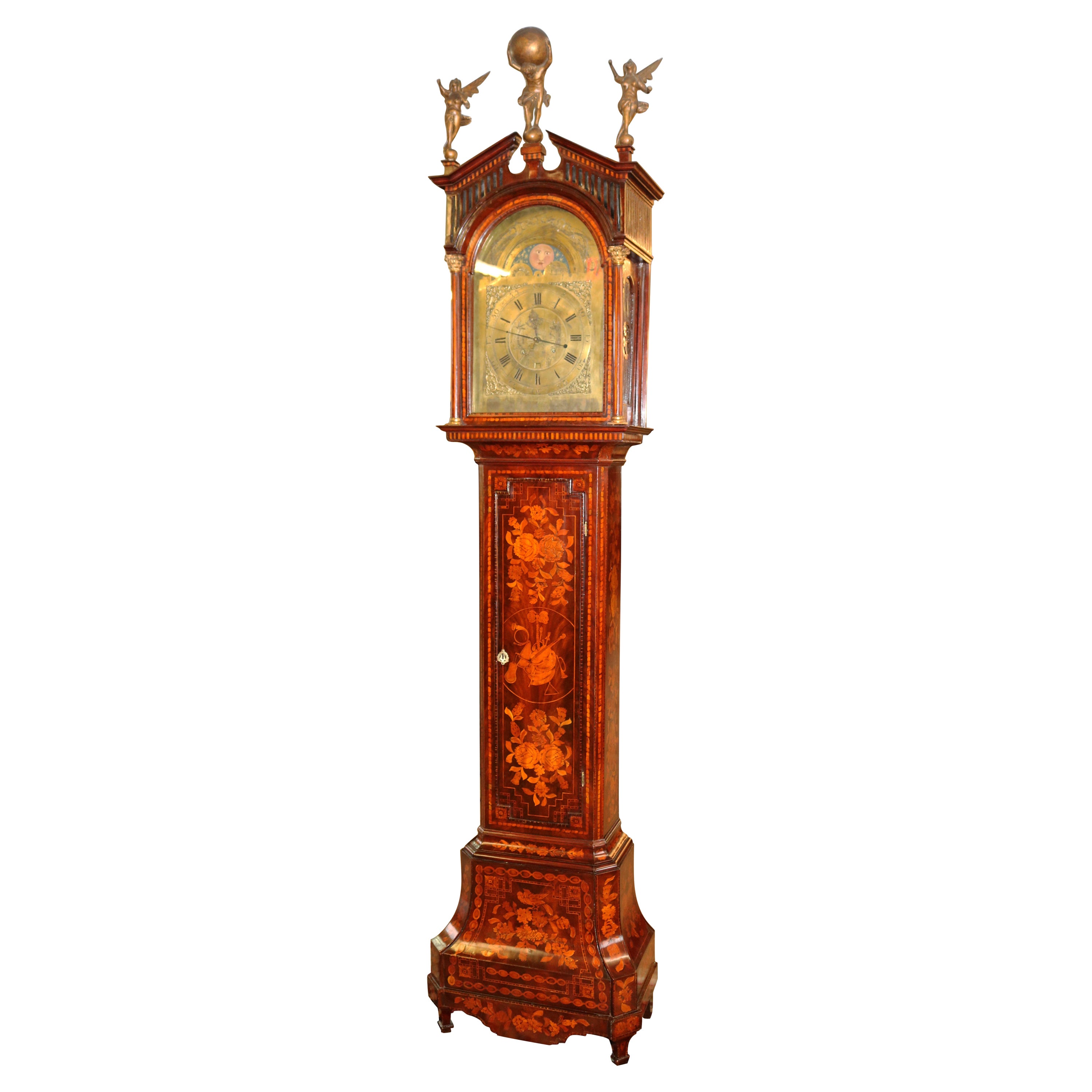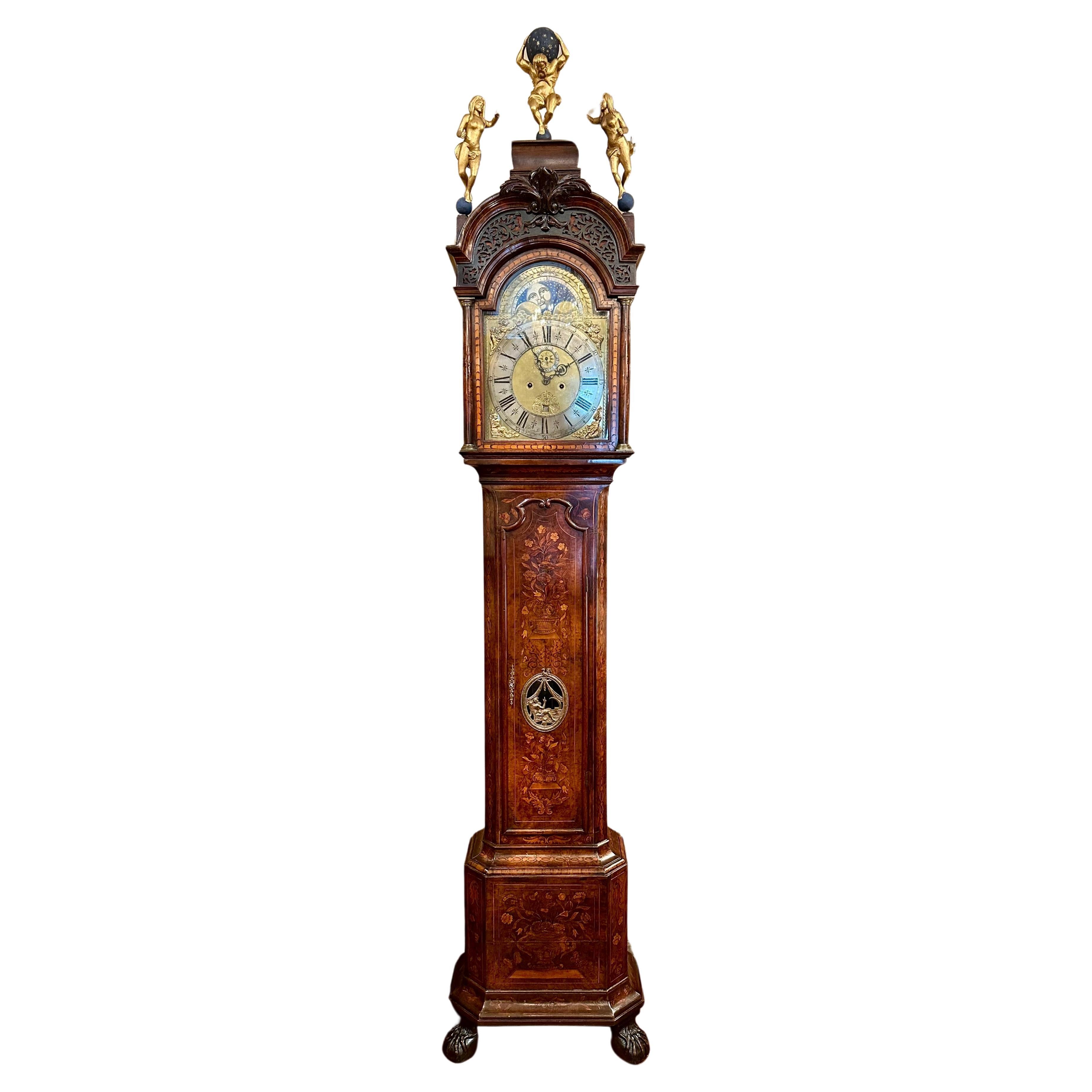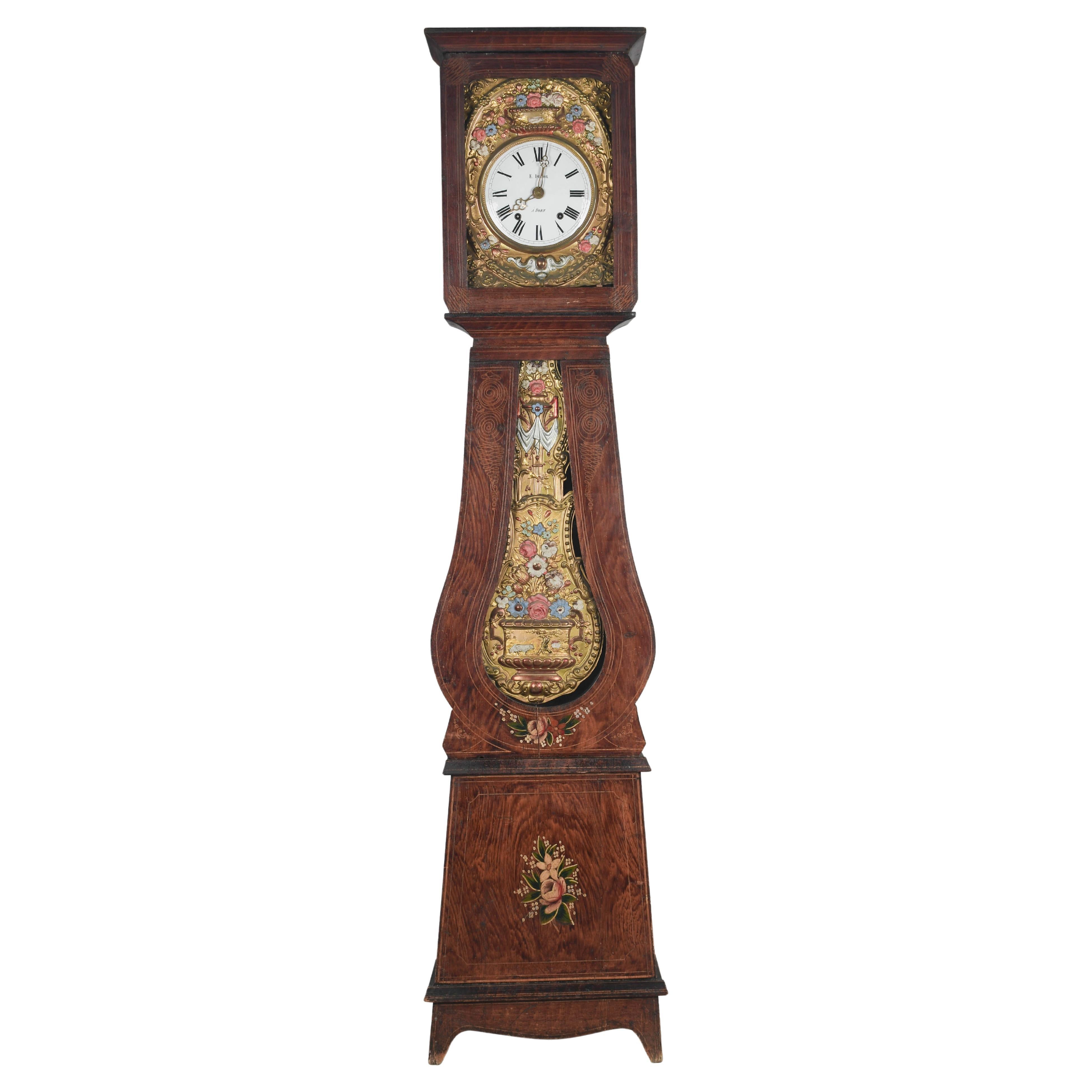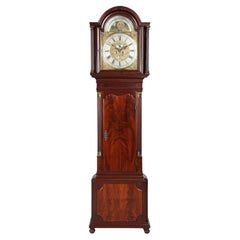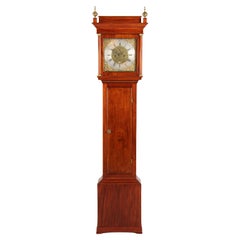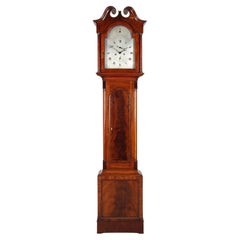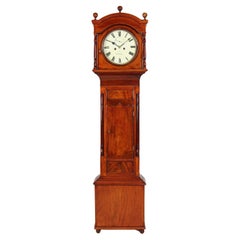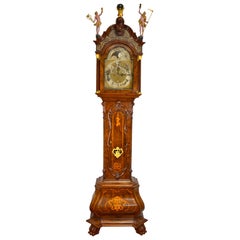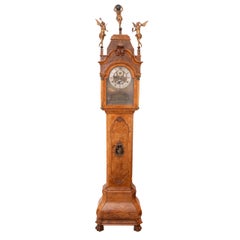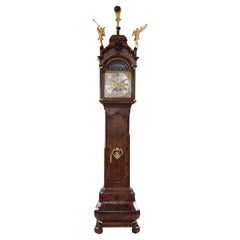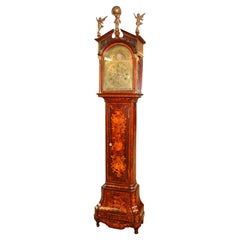Articles similaires à 18th Century Dutch Grandfather Clock, Calendar and Moonphases, Amsterdam 1760-70
Chargement de la vidéo
Vous voulez plus d'images ou de vidéos ?
Demander au vendeur plus d'images ou de vidéos
1 sur 21
18th Century Dutch Grandfather Clock, Calendar and Moonphases, Amsterdam 1760-70
15 500 €TVA incluse
À propos de cet article
Antique Amsterdam grandfather clock with alarm, calendar and moon phase
Amsterdam
Walnut root and others
circa 1760
Dimensions:
H x W x D: 283 x 58 x 30 cm - without figures the height is reduced to 241 cm
Description:
Elaborate grandfather clock in typical Amsterdam design with figure crowning.
The walnut-root veneered body with fine maple inlays stands on so-called ball-and-claw feet, which were particularly popular in the mid-18th century. The lower part of the body is, also typical of the time, strongly bulging, while the centre part is recessed in width and has a curved door at the top and bottom with thread inlays following this line. The asymmetrical, ormolu framing of the viewing window with its C-curves, flowers and rocailles corresponds to the formal language of the Rococo period.
The head of the clock is spectacular. The round arch supported by four columns with openwork above is complemented by a pedestal-like structure with carved and oil-gilt figures. On the left we see Hermes, the messenger of the gods, here as the patron saint of trade with a quill and purse; and on the right Fama, the goddess of fame with the Roman tuba in her hand. And enthroned above all this is Atlas, the Titan, holding the celestial globe.
A very similar case, with a clockwork by Otto van Meurs, is described in Jan Zeeman - De Nederlandse Staande Klok on pages 126-128. (See photo) It reads as follows:
Otto van Meurs had a particularly skilful case maker, distinguished by his refined workmanship and the beautiful colour of the walnut veneer. The inlay work on the double-curved base of the clock dates from this period. The moulded part on the pendulum window clearly shows that an elegant and playful interplay of lines was a basic requirement at this time.
It is obvious that the case of the clock on offer here comes from the workshop of this very case maker.
The dial is also particularly interesting. The moon phase and the age of the moon can be seen at the top of the arch. The fact that the moon is firmly mounted and the celestial disc rotates in front of it is unusual and therefore particularly noteworthy. This is a rare design which, in contrast to the usual rotating moon, still leaves space to the left and right of the arch. This space was used for a fine painting:
Against the expanse of the sky and in the shade of the trees, we see on the left hand side Spes, the personification of hope, leaning on an anchor and ensuring a good harvest; and on the right, Caritas as the personification of charity, here mercifully caring for the family.
Below this is a silver-plated chapter ring with black Roman numerals for the hours and Arabic numerals for the minutes, which are rotated from 20-40, typical of the time and region. The finely sawn and blued steel hands run in front of a small silver ring, which is used to set the alarm time.
Below this, we see the day of the week in a triangular window with the corresponding Greek symbol and a personification of a deity, in this case Chronos, who stands for Saturday and who limits life with his scythe. The other days of the week are symbolised by Diana, the goddess of the hunt on Monday; Ares, the god of war and battle on Tuesday; Hermes, the messenger of the gods on Wednesday; Zeus, the highest of all gods on Thursday; Venus, the goddess of love and beauty on Friday; and Apollo, the god of music and beautiful things on Sunday.
Above the winding holes we see a small sub-dial for the seconds, a window for the date and the signature of the master clockmaker - Jan Storm - Amsterdam.
The Storm family is recorded with several generations of clockmakers in Amsterdam from 1672. According to Enrico Morpurgo - Nederlandse klokken- en horlogemakers vanaf 1300, Jan Storm was active from 1717. The clock offered here probably dates from the last years of his workshop.
The weight-driven movement, with a power reserve of one week, strikes the number of hours on the half-hour and hour, and a single strike for each quarter hour.
Condition:
Very good, restored condition of movement and case. The movement has been completely dismantled, cleaned and overhauled, the case has been primed with shellac and matted with wax.
The top pedestal of the head was not present at the time of purchase and was added during the restoration according to the old model. On the photo showing the back wall of the case, you can see that the back wall was first shortened and then lengthened again, presumably for transport during a move.
We recommend the following literature for this clock:
Jan Zeeman - De Nederlandse Staande Klok
You can find out more about the creative period of the Storm clockmaking family in the following directory:
Enrico Morpurgo - Nederlandse klokken- en horlogemakers vanaf 1300
- Dimensions:Hauteur : 283 cm (111,42 po)Largeur : 58 cm (22,84 po)Profondeur : 30 cm (11,82 po)
- Style:Louis XV (De la période)
- Matériaux et techniques:
- Lieu d'origine:
- Période:1760-1769
- Date de fabrication:1760-1770
- État:Remplacements effectués: The top pedestal of the head was not present at the time of purchase and was added during the restoration according to the old model. On the photo showing the back wall of the case, you can see that the back wall was first shortened and then lengthen. Usure conforme à l'âge et à l'utilisation. Very good, restored condition of movement and case. The movement has been completely dismantled, cleaned and overhauled, the case has been primed with shellac and matted with wax.
- Adresse du vendeur:Greven, DE
- Numéro de référence:1stDibs : LU5419245432442
À propos du vendeur
4,9
Vendeur Platine
Vendeurs premium dont la note est supérieure à 4,7 et le délai de réponse de 24 heures maximum
Établi en 2014
Vendeur 1stDibs depuis 2020
193 ventes sur 1stDibs
Temps de réponse habituel : <1 heure
- ExpéditionRecherche du devis...Expédition depuis : Münster, Allemagne
- Politique des retours
Certaines parties de cette page ont été traduites automatiquement. 1stDibs ne garantit pas l'exactitude des traductions. L'anglais est la langue par défaut de ce site web.
Garantie d'authenticité
Bien qu'il soit peu probable que la situation se présente, dans le cas où vous rencontreriez un problème d'authenticité d'un article, contactez-nous dans un délai d'un an pour obtenir un remboursement intégral. DétailsGarantie de remboursement
Si votre article n'est pas conforme à la description, est endommagé pendant le transport ou ne vous est pas livré, contactez-nous sous 7 jours pour obtenir un remboursement intégral. DétailsAnnulation sous 24 heures
Vous disposez d'un délai de 24 heures pour annuler votre achat sans motif.Des vendeurs professionnels agréés
Nos vendeurs de renommée mondiale doivent respecter des normes strictes en matière de service et de qualité, afin de préserver l'intégrité de nos fiches produit.Garantie d'alignement des prix
Si vous constatez qu'un autre vendeur a mis en vente le même article à un prix inférieur sur un autre site, nous nous alignerons sur ce prix.Livraison en toute confiance à l'international
Notre réseau de transporteurs de premier ordre propose des options d'expédition spécialisées dans le monde entier, y compris des livraisons personnalisées.Plus d'articles de ce vendeur
Tout afficherFin du XVIIIe siècle - Horloge anglaise à long plateau avec phases de lune, Manchester, vers 1780
Horloge grand-père anglaise de la fin du XVIIIe siècle avec phases de lune
Angleterre (Manchester)
Acajou
seconde moitié du XVIIIe siècle
Dimensions : H x L x P : 209 x 56 x 25 cm ...
Catégorie
Antiquités, Fin du XVIIIe siècle, Anglais, Horloges de parquet
Matériaux
Acajou
Horloge grand-père anglaise du XVIIIe siècle par A James Pike
Horloge ancienne George III de Newton Abbot
Angleterre (Newton Abbot)
Acajou
vers 1790
Dimensions : H x L x P : 207 x 50 x 27 cm : H x L x P : 207 x 50 x 27 cm
Description :
Coffr...
Catégorie
Antiquités, Fin du XVIIIe siècle, Britannique, Horloges de parquet
Matériaux
Laiton
Horloge écossaise à long buffet fabriquée par William Spark, Aberdeen, vers 1820
Horloge grand-père George III avec cadran argenté
Écosse (Aberdeen)
Acajou
George III vers 1820
Dimensions : H x L x P : 222 x 47 x 23 cm
Description :
Magnifique horloge grand-pè...
Catégorie
Antiquités, années 1820, Écossais, George III, Horloges de parquet
Matériaux
Acajou
Horloge grand-père anglaise du milieu du 19e siècle avec cadran rond peint
Horloge de grand-père anglaise ancienne avec cadran peint dans une boîte en acajou
Le coffret repose sur de petits pieds ronds et présente une large partie inférieure, au-dessus de ...
Catégorie
Antiquités, Milieu du XIXe siècle, Britannique, Horloges de parquet
Matériaux
Acajou
Horloge de cheminée du XIXe siècle "Astronomie", France vers 1830
Pendule de cheminée ancienne sur le thème de l'astronomie
France
Bronze
Charles X vers 1830
Dimensions : H x L x P : 48 x 19 x 10 cm
Description :
Insolite horloge de cheminée en ...
Catégorie
Antiquités, XIXe siècle, Français, Charles X, Horloges de table et de bu...
Matériaux
Bronze
Horloge suédoise Mora Clocks du milieu du 19e siècle avec affichage de la date, vers 1850
Horloge grand-père Mora antique en bouleau massif
Suède
Bouleau
Milieu du XIXe siècle
Dimensions : H × L × P : 208 × 54 × 19 cm
Description :
Horloge de grand-père ancienne de for...
Catégorie
Antiquités, Milieu du XIXe siècle, Suédois, Horloges de parquet
Matériaux
Bouleau
Suggestions
Horloge hollandaise à long buffet ou grand-père "Utrecht" du 18ème siècle par W.V. Dadelbeek
Par W.V. Dadelbeek
Pendule hollandaise en noyer, ronce de noyer et marqueterie de W.V. Dadelbeek, Utrecht. L'étui est de forme typique, la porte du coffre est ornée d'un bandeau de plumes, la base est ...
Catégorie
Antiquités, Milieu du XVIIIe siècle, Néerlandais, Louis XV, Horloges de ...
Matériaux
Noyer
Horloge à grande caisse d'Amsterdam, signée Pieter Verlaer, vers 1840-1860
Horloge d'Amsterdam dans un grand boîtier.
Signé Pieter Verlaer,
Néerlandais, vers 1840-1860.
noyer et noyer ronce.
L'horloge possède un cadran étonnant avec trois navires qui se dép...
Catégorie
Antiquités, XIXe siècle, Néerlandais, Néo-rococo, Horloges
Matériaux
Noyer
Magnifique horloge hollandaise à long boîtier du 18e siècle
Une impressionnante horloge hollandaise à long boîtier en chêne plaqué de ronce de noyer, signée sur l'anneau de chapitre F. VAN CEULEN UTRECHT. Le capot de cette horloge présente un fronton en arc brisé avec de très belles frettes élaborées fonctionnant comme des frettes sonores, ainsi qu'un ornement proéminent sculpté de manière asymétrique. Il est surmonté de trois très belles statuettes en bois...
Catégorie
Antiquités, XVIIIe siècle, Français, Autre, Horloges de parquet
Matériaux
Bois
Horloge grand-père à grande caisse en marqueterie hollandaise figurative de la fin du XVIIIe siècle
Cette étonnante horloge à boîtier haut a été fabriquée aux Pays-Bas à la fin du XVIIIe siècle. L'étui est magnifiquement incrusté et le sommet de la hotte est orné de deux anges de c...
Catégorie
Antiquités, Fin du XVIIIe siècle, Néerlandais, Colonial hollandais, Horl...
Matériaux
Laiton
Horloge de grand-père d'Amsterdam "Pieter Paulus" en marqueterie hollandaise, vers 1730.
Ancienne horloge grand-père hollandaise en marqueterie, cadran et mouvement réalisés par Pieter Paulus, Amsterdam, Circa 1720-1740.
Catégorie
Antiquités, Début du XVIIIe siècle, Néerlandais, Horloges de parquet
Matériaux
Citronnier, Noyer
Horloge grand-père comtoise française du 19e siècle
Une comtoise ou horloge de grand-père française du XIXe siècle, avec un boîtier en pin peint en polychrome et un pendule en laiton gaufré. Mouvement Morbier à sept jours, nettoyé pro...
Catégorie
Antiquités, XIXe siècle, Français, Provincial français, Horloges de parquet
Matériaux
Laiton, Émail
